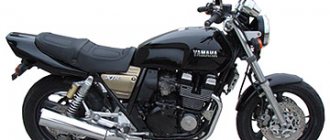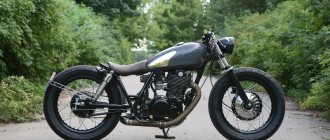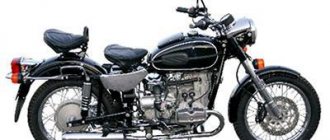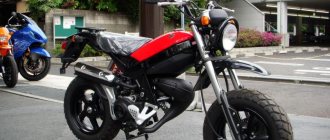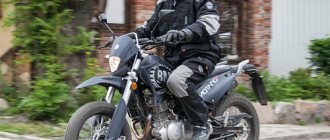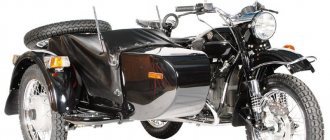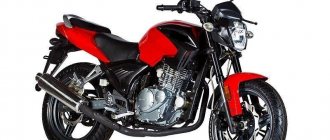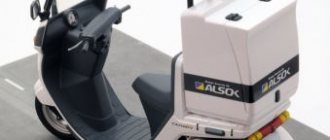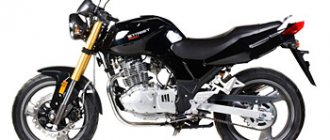When creating the Baltmotors Street 250 DD, engineers relied on the successful production experience of its 200 cc predecessor. They did not reinvent the wheel, but took an existing motorcycle, slightly improved it and presented it to the public. We must give them credit - no one even thought of passing off the Baltmotors Street 250 as a completely new model. On the contrary, in its very name it stated that this is a further development of a bike already known to us, which at one time proved itself well on the domestic market. The Baltmotors Street 250 is assembled from Chinese spare parts, but of very high quality, and under strict supervision, so the reviews from the owners of this motorcycle are mostly positive.
Even in appearance it resembles its predecessor. This, however, is only for the better - the 200 cc Street was loved by many precisely for its strict, classic appearance, without attempts to imitate another Honda or Yamaha. The gold-colored fork looks especially advantageous, intelligently shading the clip-ons and visually separating the vertical parts of the motorcycle from the horizontal ones. And in general, the appearance of the Baltmotors Street 250 DD turned out to be very nice and solid, and the bike looks organic on city streets . Unlike most other Chinese motorcycles, it does not seem archaic from the last century at all.
Design
While most motorcycle manufacturers from China continue to persistently copy famous Japanese motorcycles, trying to give their crafts at least an external resemblance to the products of famous brands, the Baltmotors company took a different path. The Street 125 DD model looks fresh, attractive and original. And there is no pretentiousness, even the gilded fork stays and the general aggressiveness of the silhouette do not give the bike the appearance of a parody of an “adult” streetfighter
The BM Street 125 DD turned out to be both catchy enough to attract attention on the road, and modest enough not to pretend to be something that it is not
Review of BM Classic 200 (2012)
Good afternoon In the first half of May, the question of buying a motorcycle really came up. In the fall of 2011, I studied for category A in addition to B and C and began to make plans for races. Of the classes into which motorcycles are divided, I am most attracted to classics and cruisers. It’s worth noting here that I like neoclassics like Kawasaki W650, W800, Triumph Bonneville, Triumph Scrambler. Twin-cylinder engines, decent displacement, big round headlight (!) and stunning trim. Calm, balanced cars are what you need. Although the British were not offended by power.
But these were dreams! I didn’t have enough income or savings to afford any of these beauties; my budget was approximately 70 thousand. But there was a classic Izh Planet Sport 350 produced in 1978, all original and with documents, but technical problems (it was put in a garage for about 8-9 years without moving) forced us to abandon it. In addition, I really didn’t like the prospect of having two-stroke oil with me when I needed to refuel. But, by the way, it’s not over yet.
I had to drive it from the store myself, despite the fact that I didn’t ride a motorcycle to the driving school, and the school only rented out the site. Hmm, I tensed up then. %) But I got to the garage without incident, covering 21 km. The seller assured that the engine had never been started since the car arrived at the store. However, he started up very cheerfully. The run then was 400 meters.
Characteristic feature: the engine can be started provided that the support leg is removed and the clutch is depressed, otherwise the starter will idle. It starts very easily, at temperatures below 18-20 you can use a choke, and when warmed up it starts with a half turn. The engine sounds quiet, at idle it resembles a scooter, and when accelerating, bass sounds appear. Naturally, the volume is small, so the sound is also not impressive. Craftsmen drill the back wall of the muffler to make the roar more interesting. I don't know if I need this..
There is clearly not enough power on the highway; the transmission gear ratios are also more tailored for the city. When accelerating to 60 km/h, I go through all five gears, so those who like to “light up” will definitely be dissatisfied. In the city, the motorcycle is nimble and obedient (I, of course, have nothing to compare it with), I happened to get into a traffic jam - I was leisurely moving along the right edge of the first lane past standing cars. I read on the forums that you need to stretch Chinese equipment yourself after purchase, so as not to lose anything on the road. I decided to do this, but when applying a reasonable torque, only 5-6 nuts/bolts/screws gave way; everything related to the engine and chassis was tightened to the utmost. Naturally, I didn’t tear up the meat. But the set of tools turned out to be incomplete: the handle for the screwdriver is missing (only two blades - a cross and a flat one) and a 14x17 wrench. The battery is maintenance-free, without plugs, but with hieroglyphs.
More about the appearance: the Classic 200 reminds me of a Suzuki Intruder, adjusted for its dimensions, of course. From the front it looks massive, the back is a little thin, and the panniers widen it a little. On the street everyone looks, turns around and follows, asking what and how. Even the traffic cop asked questions when issuing license plates
I don’t like the increased attention to myself, but I’ve already accepted it. %)
I suggest you familiarize yourself with my experience of owning a Chinese motorcycle assembled in Russia.
Purchase from a dealer. 0 km.
I bought the motorcycle from BMP Techekstrim, I liked the store.
I don’t know why I chose street, it was a temporary insanity, a quick decision, but how much time was spent reading forums and elections on the Internet. I went to buy a motard 250. I was captivated by the appearance, I always liked street fighters, but now I saw the other side of the coin... What about the sellers? The sellers said that the motorcycle had undergone pre-sale preparation, which is great, which means you don’t have to wait until you get home, great! I sat down, started it, warmed it up and drove to the gas station. Feeling glad that I finally decided to switch to two wheels in the city. After refueling, I went to the turn to the Moscow Ring Road, this is my first fast turn, the emotions are excellent, the motorcycle tilted decently for the first time! Here is the Moscow Ring Road and I’m on a motorcycle that hasn’t been broken in, I’m sick of the traffic jam, I’m not sticking around in the aisles on such a heavy (at that time) motorcycle yet. Here, in a traffic jam, I felt for myself what dealer pre-sale preparation is. The clutch stopped disengaging and stalled. Behind me, about forty centimeters, is a KAMAZ truck honking loudly, there are cars all around, the road is narrowing and undergoing repairs, and I’m standing in a row. Somehow I pushed the motorcycle, switched it to neutral and rolled back to the bump stop. Fortunately, I had experience in servicing Sovkomoto and I knew where to look. The lock nut for adjusting the clutch cable has become loose due to vibration. Sensing that it was a big deal, he quietly drove home. At home I have already found loose adjusting nuts for the throttle cable at the remote control and on the throttle, the same with the clutch cable. I noticed that the right control panel was half open; it turned out that one of the two fixing bolts had fallen out. Steering weights were added here; they dangled freely in the clip-ons. I took a screwdriver and tightened it, but it immediately became clear that the weights were resting on the gas handle, blocking throttle control. Thus, it turned out that it is necessary to move the gas handle with the remote control inward, but to do this you need to drill a new hole for the clamp, in general, nothing complicated, but this is a new motorcycle! WHAT...?
A little about comfort. He's gone. My height is 170 cm, my legs are about 70 cm. The motorcycle is high, the seating position is almost sporty in terms of torso tilt. Now imagine that you are driving to another city, 300 kilometers away. You are driving slowly, people are overtaking you from all sides, it is difficult to drive with the traffic. Added to this is pain in the lower back and arms from the special fit and strong vibration on the clip-ons (especially on the left; in the rear-view mirror it’s a mess instead of an image; you can’t make out anything at a speed of 100 km/h). For two months I still didn’t get used to the landing; an old wrist injury showed up.
Checking valve clearances. 1360 km.
Why did you decide to check?
I drove for a long time in break-in mode, however, my patience is not unlimited. I tried to turn the engine over 6k rpm. I remind you of the engine characteristics: 21 hp. at 7500 rpm, 19.5 Nm at 6000 rpm. I expected that acceleration after 6k rpm would be somewhat better, or rather much better. The fact is that the motorcycle accelerates briskly up to about 6k rpm, and after that the acceleration ends and the motorcycle just makes noise with the engine and accelerates very slowly. Suddenly, somehow, sadly or something... I need to say a few words about the process. The forums I found on the Internet say that adjusting the valves is not convenient and takes a long time. The process took me about 20 minutes, everything was very simple, although I didn’t have to adjust either the inlet or outlet, everything was within the service limits. We remove the seat and tank, and there is full access to the valve covers on the head. The process of marking, checking and adjusting valves is well described in the service manual for the Suzuki TU250. Now comes the fun part. While I was picking the valves I decided to see if the spark plug was smoked. I took a stern spark plug wrench with a handle and prepared to apply force... But there was no need to apply force, the spark plug was already sufficiently unscrewed. I unscrewed the spark plug, all the threads were covered in soot. The spark plug itself seems to be normal, the insulator is white-gray or something, the upper electrode has a white and light brown coating in places. Looks like the mixture is a little lean. I didn’t adjust the carb, I decided to add more mileage, and I assumed that there might be a problem with the spark plug. These are the surprises. So check the tightness of everything you can, Russian and Chinese assemblies, I don’t know who to blame, probably you can only blame yourself here, because you knew what kind of thing you were buying =)) Conclusion from the results of the check: the Chinese tried their best when assembling the engine, but not much, about this a little later.
Someone's crookedness. 1750 km.
The season was coming to an end for me, the variegated leaves were already falling, and I don’t like driving in a cold, damp environment at all.
I solved the storage issue on a budget and retained constant access for repairs and modernization =) I would like to share another problem that arose at about 150 kilometers. While driving, a strange squeak appeared, similar to the squeak of rubber, stopped at the curb, examined the front and rear wheels, as a result of the inspection it became clear that the rubber was not rubbing anywhere. It stood for about 5 minutes and during this time the smell disappeared and the creaking disappeared. A couple of kilometers later, history repeated itself. Upon closer inspection, it became clear that the creaking was coming from the front wheel area. There are not many options, the first of them is a defect in the anthers or bearings of the wheel hub, but the wheel rotated freely and no visible problems with the hub were found. The second option was the speedometer drive gearbox, which was still mysterious to me at that time. I decided to go to the dealer and, with the help of a professional, quickly resolve this ridiculous issue. This week I went to the dealer, taking a vacation at my own expense, because the mechanic only works on weekdays. The dealer gave a simple answer: “Come for the first maintenance, if the sound does not disappear, then we will solve the problem.” Then I realized that contacting the dealer regarding warranty issues would be a rather difficult undertaking.
The sound actually practically disappeared after about 400 kilometers and now it didn’t bother me much, but it didn’t disappear at all. Having arrived for the first maintenance, I admit honestly, this problem had already flown out of my head, because a new one appeared during the maintenance. The mechanic, without any service manual, began to change the oil, my advice was not to unscrew the plug under which it is located, known on specialized forums, he did not take the mechanism for tightening/fixing the rocker seriously and still unscrewed that bolt. A spring and a latch holding the rocker fell out of the hole along with the oil. The mechanic's face was unwavering and he allegedly did not notice any problems. I drew his attention to the spare parts dangling in the basin. Everything would have been fine, but he installed the mechanism back incorrectly, as it turned out a little later. Later, I myself had to unscrew this bolt and, holding the oil with one hand, which was trying to leave the crankcase, with the other hand, change the position of the rocker lock and deftly place the mechanism back with minimal oil loss. While performing the so-called “maintenance”, the mechanic noticed that the chain was overstretched and tightened it. I checked the tension level, the tension was like that of a winch cable pulling out a cruiser stuck in thick mud. I asked, at “my own peril and risk,” to loosen the tension precisely adjusted by the mechanic and went home, and then I felt that the gearshift foot was too loose and was not fixed accurately, then I thought about the rocker mechanism... Okay, what’s done is done. Returning to the sound in the front wheel. At about 1,750 km, the season is over, the motor is at home and ready for repair. Removing the wheel turned out to be quite difficult. Apparently assemblers in China also do not have any information on the tightening torques of threaded connections and tighten the nuts “reliably and tightly.” Somehow we managed to loosen and remove the nut, having previously dismantled the brake calipers, removed the wheel, removed a ton of grease from the gearbox and saw the problem itself, in fact, the profiled washer that should connect the wheel and the gearbox mechanism was bent inward and was clinging to the gearbox housing and the wheel. There is a groove left on the wheel from this washer. Thus, the mechanism could not work normally and show reliable data; apparently it was slipping. And the creaking of rubber came from a large boot inside the wheel hub, which became very hot due to metal friction, so much so that it even began to melt. The gearbox was disassembled and the washer was straightened. I assembled the gearbox, lubricated it and installed it exactly in the grooves, which the assemblers at the factory were unable to do. Well, it’s good that the engines are assembled in China.
A little about liquids and threaded connections. 1750 km.
After purchase, do not be lazy to change the oil after 300 km and the brake fluid.
I can’t say anything about the quality of the engine oil filled at the factory; I replaced it at 950+ km, and it was black. When running in, do not trust the tachometer, this “display meter” can blatantly lie. The brake fluid in the front brake system was replaced in the summer of 2014. Even then the brake guard was somewhat different from the new one in a darker color; I didn’t see the need to take photographs then, and there was no desire to share information. Just in case, I decided to replace the brake fluid in the rear brake system. When I opened the expansion tank, there was no longer any doubt about the need for this procedure, just look at the photo - this is the liquid approximately a year after it was filled at the factory and is fresh for comparison. It seems that this liquid has corroded the rubber seals and hoses, but the brake works normally.
Threaded connections must be checked without leaving the cash register, I have already written about this, but the problem may be somewhat broader. During the winter I slowly tinkered with the motorcycle and learned about other hidden problems. It turned out that the motorcycle has internal threads that became victims of a lazy/tired Chinese who was working the third shift; I had to use a tap with a wrench on these threads and replace the damaged screws with stainless steel ones. New stainless steel screws are much stronger and do not behave like plasticine. Don’t forget about the screw sealant; I use a collapsible medium-fix sealant.
Pay special attention to the tightening torque, since the service manual is not among the information available on the Internet, would it be logical to use the manual? ancestor? Suzuki GN250 or TU250X, however, information on tightening torques can only be applied to the engine and then adjusted for the quality of the materials of the bolts, parts and crankcase. I checked the tightness of the engine bolts according to the manual and found that the right engine cover gasket was leaking. The gasket was even squeezed out by ~1mm, and the reason was the random unscrewing of the engine cover screws. There are rubber gaskets installed under the heads of these bolts, perhaps this is done to prevent them from unscrewing or oil leaking through the bolts. Be that as it may, the bolts are unscrewed periodically, although they are tightened according to the manual - 10 Nm, using a not-so-cheap torque wrench. After the third pull they do not unscrew. Keep an eye on those screws.
What happens when you use tightening torques focusing on Japanese quality? You have to buy a tap, a driver and a drill for the tap, then learn how to do interesting work, it’s been tested.
Improvements. 1750 km.
In winter I made several improvements in the area of comfort and safety.
First, an ADELIN 17.5 mm front radial brake machine was ordered as an inexpensive and reliable option. At the Motorcycle Hobby store I bought a Chinese SS 182 tidy, a brake hose reinforced with Venhill prefabricated fittings, a TRW sportbike handlebar with a slight rise and TRW handlebar weights. I also ordered a lot on Aliexpress. There are steering racks to the steering wheel and, due to the increase in the distance from the yoke to the remote controls on the new steering wheel, I had to buy a throttle and clutch cable from a Suzuki GN 250. Not bad LED turn signals and relays for them were also purchased there, as well as new waterproof HID connectors for pairing the new device and wiring, as well as cylindrical neodymium magnets with a diameter suitable for installation in the brake disc screws. Next, the following work was carried out:
1. Dismantling of remote controls, handles, clip-ons, tidy, upper crossbar, turn signals and turn signal relays.
2. The machine drilled the upper traverse in the reinforcement zones, which does not look reliable, but the other options are too expensive and time-consuming. I’ll say in advance that nothing has fallen off yet, it’s holding securely and I’m calm about this unit.
3. The prepared traverse was installed in place, the steering columns and the steering wheel itself were mounted through a system of washers and rubber gaskets, of course, after some modification of the Chinese pillars using needle files. Places for drilling the steering wheel for the remote controls were determined and holes were drilled. Remote controls, handles and steering weights are installed.
4. Clutch and throttle cables have been replaced. The throttle cable did not fit the remote control and the interface had to be modified using a harsh nut and fasteners in the form of a stainless steel bolt and nut.
5. The instrument panel mounting bracket has been modified - three holes have been drilled for a new instrument panel, 4 layers of splen have been laid as a decoupler between the panel body and the bracket. The tidy is secured using stainless screws with a rubber gasket.
6. The most difficult part for me is remaking the connectors for the new device. We purchased a crimper/stripper and, armed with a datasheet for the device, began the process of searching for the necessary cutting and crimping wires for the new Chinese connectors. Nothing complicated, as it turned out, the main thing is a little free time and desire.
7. Installation of the tidy with bracket. Cutting out the bracket for the Hall sensor on the wheel, installing and laying the cable for it. Installation of neodymium magnets in the brake disc screws, they had to be sharpened with a needle when installing them in place.
8. Assembling and installing a reinforced brake hose, connecting cables and everything that is not yet in place.
The result of the work was an increase in safety and operating comfort. At first glance, the seating position has not changed radically; a slight forward tilt remains, but the discomfort on the road and when stopping has disappeared. The most important thing is that vibration on the steering wheel at high speeds is compensated! The ground clearance increased to 19 cm due to the modification from clip-ons to the steering wheel (the fork was recessed a little lower in the traverses). The brake machine works a little harshly, you need to get used to reducing the force on the handle, but now you can ride with normal gloves and brake with one or two fingers. The instrumentation is easy to read, GPS speed indicators are set up, the tachometer is especially epic and easy to read, it may not be needed on such a moped, but it looks beautiful with its accompanying lighting.
In winter, thanks to this technique, I began to understand a little about motorcycle electrics, learned how to cut threads, gained new experience in altering and modifying equipment, and also acquired a new tool that will come in handy.
Engine failures. Complete carburetor overhaul with cleaning and replacement of GTZ. 2500 km.
It was decided to completely disassemble the carb, clean it thoroughly, and set the level in the float chamber.
The reason for this was a floating problem with interruptions in engine operation in partial load modes around the quarter throttle opening. Before this problem arose, I changed the main fuel jet to 148, as it turned out it was too large for the engine to operate, because a direct-flow exhaust was not installed. Therefore, I decided that the problem was related to interference with the carb. I decided to look for a more optimal combination of GTZ of different capacity and position of the dosing needle, after about 8 hours of endless disassembly, assembly and testing, I decided to return the stock GTZ, set the needle to the middle position and installed the intake muffler in place. The result was the same, the failures were as they were. In neutral, turn the throttle gradually in the region of 4 - 4.5 thousand rpm. There were interruptions in engine operation and popping noises from the muffler. It was a shame that I thought about electronic ignition. But after consulting with a friend, I decided to pick out the carb and clean it completely. A short instruction: How to pick out the Teikei MV30 carb? Nothing could be easier! Close the fuel valve and disconnect the fuel hose from it. Remove the throttle cable from the carb. Disconnect the carb from the intake manifold on both sides by unscrewing the clamp screws and unscrew the air filter box to freely remove the carb. Drain the gasoline by unscrewing the screw at the bottom of the float chamber (bottom of the carb), fuel will flow from the tube into a previously prepared container. Disassemble the float chamber by unscrewing 4 screws, be careful with the screws, I tore one off when tightening and replaced it with an extended one with a nut. We pull down the chamber tray and immediately wipe off the gasket from the gasoline, otherwise we will wait a long time for it to shrink back. Next, using screwdrivers and suitable wrenches, unscrew the main jet from the end of the emulsion tube (the largest one, located in the center) and the emulsion tube itself, then unscrew the idle jet (next to the main one). Next, we knock out the float axis in the direction indicated by the arrow using a hammer, a Phillips screwdriver and a hexagon or nail of suitable diameter, but it is better to use a suitable drift. We remove the float with the needle valve, unscrew the screw securing the needle valve seat and use pliers to pull out the seat. We remove the mesh from the inside of the saddle, we are surprised how dirty everything is, we remove the o-ring from the saddle. We unscrew the two screws on the side of the carb that secure the mixture enrichment membrane when the throttle valve is abruptly closed, it is pressed by a spring and can shoot out, be careful. We remove the membrane cover, spring, release the membrane from the groove by the ear and carefully pull it out from both sides. Next, unscrew the idle mixture quality screw. Remove the O-ring, washer and spring from the screw. Next, remove the cover of the upper membrane on which the needle is attached. To do this, unscrew the two screws and remove the cover, immediately remove the spring and the membrane itself with the spool, very carefully wipe off the gasoline with a clean rag so that it does not swell too much. By pressing upward on the metering needle, we take out the white latch on which the spring presses, take out the needle itself and from the side of the confuser (the tube through which air goes into the carb) press on the needle guide, it should fall into the palm from the side of the needle valve seat. We unscrew the choke. Now we take a small jar, put all the small metal parts in there and fill it with carb cleaner. Do not allow carb cleaner to come into contact with rubber and plastic parts; it may contain solvents that damage the structure of rubber and plastic. Make sure that all rubber is removed from the carb and begin cleaning all channels and cavities with carb cleaner. Be careful with your eyes; splashes of corrosive chemicals often fly into them from an intricate network of channels. We check the position of the stopper on the needle; the middle position seemed optimal. We clean everything and put it back together. Be careful with membranes and gaskets, it’s better to wait a day until they shrink or you’ll have to use mats to secure them in the grooves. Lubricate the seat of the locking needle seat with gasoline during assembly, otherwise you will not get it into place. We check the level in the float chamber after assembly; due to the lack of a manual, I aligned the floats along the weld seam on their plastic parallel to the body. Check that the floats are level with each other. Press the float axle very evenly so that there is an equal distance on each side from the edges of the posts; an axle sticking out on one side may prevent the float chamber pan from being seated properly. Tighten the mixture quality screw and unscrew it 2.5 turns. The carb is assembled and ready for installation. After the work was done, I started the engine, let it warm up and checked for any dips. I spin the engine a little bit and nothing happens, the engine runs without any problems. Next, I adjusted the quality of the mixture after complete warming up during a test ride, this is done quite simply. We set low stable speeds and look for extrema by turning the quality screw at which the engine will begin to operate unstably and set the average position of the screw relative to the positions of the extrema. We reduce the speed to a stable speed and repeat the operation. Regarding the GTZ, I installed 142, in stock 126. I removed the intake muffler and got a noticeable improvement in the upper rev range. At the bottom and middle, the bike also didn’t lose, but rather gained. You will have to try a smaller GTZ; without equipment and a stand it is difficult to determine the quality of the mixture. Nothing is visible on the spark plug insulator, it is clean, perhaps the spark plug quickly reaches the self-cleaning temperature. A colder candle has already been purchased for experiments, which have shown that the candle still remains clean.
Changing the fork oil. I don't remember the mileage =)
It was warm and I wanted to get started with my motorcycle.
The main tasks are to change the oil in the engine and fork. Arriving one still not very warm day, I changed the engine oil with the same Motul, well, I know it’s expensive for such equipment, but I want to. It started up as if there had never been any winter, the starter, as usual, just made a sound, and the engine was already rumbled. The next day off I combined business with pleasure, decided to change the oil in the fork and go for a ride. Armed with the knowledge of a dozen videos about disassembling motorcycle forks, I set to work. Only five hours of swearing, bloodshed and hundreds of attempts to disassemble this mysterious mechanism did not lead to disassembly (as it now turns out, I didn’t watch the video well and didn’t read the service manual for motorcycles with inverted forks). It was decided to replace the oil with fresh oil without disassembling the shock absorbers; Motul 10w fork oil seemed to me not a bad option (perhaps in vain, I should have tried 5W). Solving the problem of disassembling the fork would help reduce the oil change time by 70 minutes. Since I decided to expel all the oil from the mechanism, I had to spend this time endlessly pushing the fork shock absorber rod, which was more like working out in the gym on the uneven bars. This way I drained all the oil, at least it didn’t squelch when working. Next was the process of measuring the volume of drained oil with a small syringe of 10 cubic meters, and with a guideline of 220-240 ml per pen, I began to select the amount based on the full operation of the fork to the limiter. It turned out to be around the same 220-240 ml, the Chinese measured it exactly at the factory. During the pumping process, since my hands hurt wildly from focusing on a small area, I had to take a board and, resting its center on the shock absorber cover, pump it with its entire weight 30-40 times, one feather quickly pumped, and the other clearly intended to make me blue in the face. Fortunately, everything ended well except for the most important thing, for which the oil in the fork was changed. The fork did not become softer, however, I noticed an interesting dependence of the degree of smooth operation of the fork on the tightening torque of the traverse screws. Since there is no manual for this creation of the Chinese genius, an important question remains: how hard to pull so that the fork works smoothly and the screws do not unscrew, and even so that on a steep bump the fork does not spit out upward through the yoke. Sea trials were successful, although there were no particularly bad roads and no bumps. It doesn’t seem to have gotten any softer, or maybe I just got used to this harshness over the winter. Later it became clear that the stiffness of the fork was caused by the large preload of the spring due to its length and/or its high rigidity. During the service, a surprise awaited me in the form of two collapsed fasteners for the side plastic of the tail. They didn’t throw the moth onto the plastic, they didn’t kick it with their hands, but these ears just took it and fell apart. Most likely the reason is in the spacer bushings with damping rubber. This bushing initially rested on the part of the fastening on the frame, where the thread begins, and later it began to deform and fall deeper and flatten the ears of the plastic. When removing the front wheel, I found a bunch of dirt under the anthers of the wheel hub, it looks like the anthers were chosen poorly or the anthers are so straight, the dirt was cleaned, lithol was tucked inside the boot, because I haven’t bought special lubricant for the anthers yet.
Additionally, I found a rattling license plate, as I thought, but everything turned out to be more interesting. The screws securing the rear fender mount with the number came loose, one was lost and one was spinning on the remaining thread. There were no grommets under the old screws, nor was there a thread lock. Fortunately, I got hold of a high-quality thread locker and found the screws were not bad.
Comparison with an expensive toy.
Maybe I'm a bit of a perfectionist and that's probably where the problem lies.
I had the opportunity to drive another vehicle, road, medium-sized and relatively new (Kava ER-6n 2012). My impressions and thoughts when changing from bolt to Ruff:
1. The ruff is much heavier than the bolt, but this does not interfere with traffic jams; it is more stable at low speeds. 2. Ruff is very powerful 72 HP (HA HA AH), even excessive, as it seemed to me, but why should I overtake that sports corvette and be surprised to observe the figures of 140 km/h in the city after a few seconds of short acceleration? You have to very accurately and carefully measure the opening of the throttles in wet weather, which is especially important on plastic crossing surfaces, otherwise you have to catch the rear. 3. I was not pleased with the fuel consumption of the Ruff. The tank is 15 liters, which in the city is enough for 150-170 km, and needs to be refilled every few days. The bolt has to be refilled once a week at the same intensity of use, because the bolt's tank is 21-22 liters. 4. I was surprised to discover that I can’t drive onto this mediocre sidewalk and the worst thing is that I just can’t move off it, but I’m used to leaving my motorcycle right near the entrance to work, where it is at least somehow protected from precipitation and from encroachment. And this is one of the most significant disadvantages for me. 5. You constantly worry about Ruff because of the cost, its weight and low ground clearance.
Thus, by switching to a branded road car, I lost many freedoms that I previously took for granted and I don’t want to lose them in exchange for speed characteristics. The bolt turned out to be quite good, you don’t worry about it when you go somewhere on business, you can even storm stairs with it, it will pass, I’m sure. Yes, it does not have fast acceleration, I won’t even overtake this Golf 1.6 if they don’t let me overtake myself, however, the bolt has other qualities that are important for a person with a small income. Even if I leave Moscow, then the motorcycle does not sadden me, it is ready to ride along with pensioners at its 115 km/h or even lying on the tank to overtake this daring truck at a speed of 125 km/h, spinning the engine until it rings, but its comfortable speed on the highway, about 90-100 km/h is one of the best speeds for traveling, at this speed you have time to look where you are going, this speed also gives time to react, fortunately the brakes are very good. Some people put the front sprocket one tooth larger and the maximum speed increases slightly. The tires raise questions, they don’t seem to be bad, but they can hardly be called good, it’s quite easy to lock the wheels, maybe because of the rubber, maybe because of the low weight. After the modification, the bolt became a completely convenient and problem-free small-capacity universal city motorcycle.
This was my impression of the bolt at that time. But there is still tar, the bolt is not suitable for those who like to burn, it is not particularly beautiful, can a Chinese be beautiful at all?) But it carries my ass, although it does not “ride” at the same time. The motorcycle made me happy, now it is sold, a cheap workhorse for the city, for people who are ready to tinker with technology. And I’m somehow hooked on the new “powerful moped.”
Latest questions
- Is it possible to restore the appearance of plastic motorcycle parts? 1
- Who uses Scala Rider Freecom 1? Need 2 reviews
- Help me identify the Honda CB400SF for training or not 3
- How to properly take turns when descending a mountain. Serpentine. 5
- How to clean green-bluish oxides from the battery terminals. 3
- Generator stator 3 burns out
- Recommend a spendthrift for the second season 16
- Painting pendulum 3
- Black Friday 11
- Help a girl choose her first motorcycle. 27
- Where to put money 18
- Recommend a touring motorcycle jacket. 9
- Contract engine 6
- A few questions about operation. 6
- What motorcycle accessories do you use? 9
- Nikasil or cast iron that is the question 5
- I am going to Cyprus in early January 2022. Maybe someone else is coming from the bike post? 1
- Bots Forma Axel 2
- Tell me about the compressor for pneumatic tools - what is the diameter of the hose? 5
- Girl beginner biker) choice of moto) 32
Similar models
- Stels Flex 250. It has been in production for a long time, and during this time it has managed to acquire an entire army of loyal fans.
- Racer Nitro 250 and Racer Magnum 250. Both of them are equipped with identical engines, but differ from each other in appearance.
- Irbis GR 250. A popular and inexpensive motorcycle that has proven itself due to the combination of an affordable price and fairly high reliability.
Handles Baltmotors BM500-Max ATV
The console shelf begins with the winch control buttons and ends with the choke lever.
The trousers transform into elegant shorts. And unlike the Diamond Arm, it’s easy and quick, freeing up a large trunk. The winch looks convincing and pulls confidently. The entire front guard is made of metal, no plastic. Inspires! The tie rod ends, unlike the driveshafts running from the transfer case to the axles, do not evoke a feeling of monumentality. The tidy is not utilitarianly generous with information about everything. The console shelf begins with the winch control buttons and ends with the choke lever. The trousers transform into elegant shorts. And unlike the Diamond Arm, it’s easy and quick, freeing up a large trunk. The winch looks convincing and pulls confidently. The entire front guard is made of metal, no plastic. Inspires! The tie rod ends, unlike the driveshafts running from the transfer case to the axles, do not evoke a feeling of monumentality. The tidy is not utilitarianly generous with information about everything. Returning from the swamp, I caught myself thinking that you shouldn’t constantly demand from your favorite machine that it jump above your head and dive below the baseboard. He has already proven that a quadric can do this. But in a quiet walking mode, driving is no more boring than “burning” - you can pay more attention to the nature of the region conquered from the Germans.
Peculiarities
- Fuel tank 22 l . One of the best indicators among small-capacity models. According to reviews, you can travel up to 700 km at one gas station.
The tank neck is locked with a key.
The tidy consists of dial indicators combined into a single plastic block.
49CS0135
IT'S NOT HARD TO COMMUNICATE...
On the ground, the metaphorical connection with the world of aviation was severed. The new machine is completely different from last year's ATV with the same name. To be honest, having seen enough of Russian-Chinese technology, for a long time I could not believe that the cute red quad that was given to me to be torn to pieces was designed and assembled here, albeit from Chinese components. Having long been accustomed to consider the ZIL refrigerator of stagnant times as a model of domestic products, I did not detect any clumsy design, no flash of poorly fitted cheap plastic, and not even a hint of poor quality assembly, characteristic of Chinese products. Surprisingly, it’s a fact - the “red” one earned a full “A” for aesthetics and tactile qualities: no cheap linings made of slippery plastic - everything was thought out no worse than on the “Japanese” and “Americans”.
Remote control Baltmotors BM500-Max ATV
Does the remote control remind you of anything?
What if you take a closer look? I've already seen this somewhere - on a Yamaha Grizzly. Does the remote control remind you of anything? What if you take a closer look? I've already seen this somewhere - on a Yamaha Grizzly. GENERAL EFFECT
But the bad head, as always, does not give rest; For a couple of spectacular shots, I again return to frisky (but not extreme) driving through fields and meadows. And then trouble happened: after a couple of spectacular “nickels” I felt that something was wrong: I turned the steering wheel, but the quad was moving first to the right, then to the left and it didn’t respond to the steering wheel at all. Having stopped and looked under the front end, I was dumbfounded: the tip of the tie rod had burst at the place where it was attached to the steering column, and the rod itself had pierced the CV joint boot with its sharp edge. This is how the cards turned out, that the winner was taken away from the battlefield as the vanquished.
Flaws
With the exception of the incomprehensible idea of installing sports clip-ons on a city bike, other disadvantages are minor. Users noted:
- Vibrations . The usual story for cylinder 1, but the owner of the Baltmotors street will have to often check the tightness of all kinds of locknuts.
- Clip-ons . An incomprehensible idea from the developers, especially considering that the hexagons on which they are attached will require a special wrench for tightening. You will have to check it often, so you need to buy a key. Or replace the clip-ons with a classic steering wheel:
Baltmotors Enduro 250 DD
| Engine | |
| Working volume, cubic cm: | 249 |
| Engine's type: | 4 stroke |
| Number of cylinders: | 1 |
| Cooling type: | Air-oil cooling |
| Maximum power kW (hp) / rev. Min: | 15,4 (21) / 7500 |
| Torque, Nm / rpm: | 19,5 / 6000 |
| Compression ratio: | 9,5 : 1 |
| Cylinder diameter and piston stroke, mm: | 72 x 61.2 |
| Supply system: | Carburetor: TK, MV30 |
| Ignition system: | Electronic CDI |
| Engine starting system: | Electric starter |
| Fuel type: | AI-92 |
| Frame and chassis | |
| Frame(type): | Steel, tubular |
| Transmission: | Mechanical 5-speed |
| Front/rear brake: | Disk/Disk |
| Front tire: | 110/70 x 17″ |
| Rear tire: | 130/70 x 17″ |
| Front suspension: | Inverted telescopic fork |
| Rear suspension: | Pendulum with central monoshock absorber |
| Dimensions and weight | |
| Wheelbase, mm: | 1405 |
| Dry weight, kg: | 142 |
| Length / Width / Height, mm: | 2120 / 830 / 1140 |
| Seat height, mm: | 840 |
| Ground clearance, mm: | 230 |
| Fuel tank, l: | 10,6 |
| Maximum load, kg: | 276 |
| Flow and speed * | |
| Consumption 1l/100km City: | 3,2 |
| Consumption 1l/100km Route: | 2,9 |
| Consumption 1l/100km Mixed: 3 | |
| Maximum speed km/h: | 120 |
* Average fuel consumption, which may vary depending on driving style, driving speed and other factors.
Dimensions and weight
- The dry weight of the motorcycle is 156 kg .
- Equipped, taking into account a full tank and all process fluids - 180 kg .
Dimensions as for a road motorcycle:
- length - 2,066 mm;
- width - 761 mm;
- height - 1,081 mm;
Seat height - 801 mm .
Wheelbase - 1,510 mm .
Ground clearance - 191 mm .
For whom is it intended?
The model is optimal for daily trips on city streets and trips out of town on weekends.
A high seating position implies that the biker must be tall.
However, users note that the optimal motorcycle will be for an owner whose height is in the range of 162–175 cm . However, you need to be prepared that the mirror stands will have to be built up.
Repair and tuning
The structurally simple Baltmotors Street 125 DD is easy to repair and maintain. For obvious reasons, there is no specialized tuning for it, but there are plenty of universal Chinese-made options.
Repair
Any beginner can understand the design of the bike; it is very simple and at the same time logical from a design point of view. Even without a manual, you can assemble and disassemble it right in the garage, if only you had the tools, straight arms and desire. Maintenance is even less difficult.
Spare parts
This is a headache for all owners of Baltmotors Street 125. Even when the bike was released, dealers had almost no spare parts in stock, and sometimes it took several months to wait for them to order. Now, years after the model was discontinued, many components are completely impossible to find on sale, so you have to look for them “by hand.”
Tuning
Usually, owners of the Street 125DD are limited to minor cosmetic changes - grips, footpegs, stickers and similar little things. This is partly due to the reluctance to invest money in a cheap motorcycle that will be sold in a season or two, and partly due to the lack of need to tune it. He's pretty good anyway.
Specifications
Strictly speaking, this model was designed in China, and was only assembled in Russia. Taking as a basis some of the developments of their Japanese colleagues, Chinese engineers put them together, resulting in a viable hybrid that can not only compete equally with analogues in its price category, but also surpass them in most parameters.
Engine
The Chinese did not reinvent the wheel, but simply copied a simple 2-valve 1-cylinder air-cooled engine installed on Japanese motorcycles in the late 80s of the 20th century. Its characteristics are modest, only 11.5 hp, and to get them all, the engine will have to be mercilessly turned to 9500 rpm. But the extremely primitive engine is extremely reliable, and no one has heard of problems with it. Fuel is supplied through a carburetor, which is easily regulated and, if necessary, cleaned. The maximum speed that Baltmotors Street 125 can reach is 100 km/h.
Transmission
The 5-speed gearbox is also a Japanese heritage, and also comes from the last century. The gear ratios are short, so in the city you have to constantly shift, actively working both the clutch and the gas handle to maintain dynamics. You can shift to fifth gear as early as 60 km/h, so you will most likely use it mainly. There are no complaints about the operation of the checkpoint.
Chassis and brakes
One of the main advantages of the BM Street 125 is its chassis. The designers managed to fit an inverted fork and as many as 3 brake discs into the budget bike! At the rear, of course, there is a regular swingarm with a monoshock absorber, but, nevertheless, how often do you come across such a set on motorcycles in this price category? There are 2 discs with 2-piston calipers at the front, and one disc with 1-piston caliper at the rear, and this is enough to easily stop the bike even at maximum speed.
Electronics
Since there are no auxiliary systems in this model, the complexity of the electronics is comparable to a Voskhod or Ural collecting dust in grandfather’s garage. A compact 12-volt battery, a generator, a switch, fuses, a bundle of wires - that's all, there's nothing else here
After purchase, it is advisable to check the condition of the electrical wiring, paying special attention to insulation - there are problems with it on older motorcycles
Weight and dimensions
Due to its simple design and massive steel frame, the bike weighs a lot; the curb weight exceeds 140 kg. It does not seem heavy, but it is worth considering that the weight, significant by the standards of the class of small-capacity road cars, has a negative effect on the acceleration dynamics and braking distance. The dimensions of the motorcycle are quite “adult”, but the triangle of the saddle, handlebars (more precisely, clip-ons) and footpegs are grouped in such a way that it will be a bit cramped for a tall motorcyclist on Baltmotors Street 125. Ergonomics leave much to be desired.
Controllability
Despite its decent weight, the bike handles easily and predictably. It obeys the steering wheel perfectly, and with a slight tilt of the body the pilot can give it the desired trajectory of movement. This advantage makes it very well suited for learning to ride, and as a “learning desk” it can perform no worse than the popular YBR-125.
Fuel consumption
On average, Baltmotors Street 125 consumes about 3 liters per 100 km. Quite a lot for a 125 cc small-capacity engine, but such high consumption is due to the old-fashioned engine, a simple carburetor and the considerable weight of the bike. But it easily digests any gasoline you might like to pour into it.
Devices Baltmotors BM500-Max ATV
The tidy is not utilitarianly generous with information about everything that happens to the quadric.
The tidy is not utilitarianly generous with information about everything that happens to the quadric. So it turns out that each node of a quadric is like a node of a crystal lattice: everything is in its place and one complements the other exactly as much as it is needed.
...EASILY IN THE CASE OF DEFEAT
In order not to be lyrical and unfounded, here are a couple of real situations.
Arable land. Sandy dry soil. We turn on the rear-wheel drive, move back in the seat, having previously unfastened the passenger seat to load the drive wheels and, like a sportsman, we rush in a stance, raising clouds of dust. The photographer swears - he is allergic to dust. Therefore, we drive in a swamp, having previously engaged all-wheel drive, but without locking (it’s worth mentioning here that the transfer case control panel was copied or borrowed from a Yamaha Grizzly), so as not to lose control. The car overcomes muddy fords without the slightest effort, even leaving a low gear and differential locks in reserve. In the same stock there is a winch with a control panel on the steering wheel handle. Why then the stock? The answer forms itself when you look at the shiny bump of the tow bar.
Advantages and disadvantages
Advantages
- Excellent braking system with three discs and reinforced hoses. Baltmotors Street 250 stops dead in its tracks, but for beginners there is a risk of accidentally pressing the brake.
- Speedometer. He regularly lies, and to a large extent. As GPS measurements taken by some owners show, at a speed of 110 km/h (according to the speedometer), the deviation can reach 15-20 km/h.
- High reliability of all main components. The engine, for example, is an exact copy of the Suzuki TU250X engine.
- Design. The bike looks very stylish and at the same time quite modern.
- Huge 22-liter gas tank. Without refueling, Baltmotors Street 250 can travel up to 600-700 kilometers.
Flaws
- A peculiar shape of the tank. Long-legged riders may not find it very comfortable to hug it with their legs, as their lower limbs will likely not fit into the designated recesses on the sides.
- Inconvenient valve adjustment. For this operation, special windows are made in the CPG body, but it is quite difficult to get to them with tools in your hands.
- Mediocre directional stability. At high speed, the Baltmotors Street 250 DD behaves quite nervously, and sometimes you have to “catch” it, especially on uneven asphalt.
Modifications and competitors
Among the Baltmotors model range you can find the Baltmotors motard 250 dd .
Baltmotors Motard 250 DD – the model belongs to the enduro class.
In terms of performance characteristics, it is similar to a road car, a little weaker. But:
- comfortable classic fit;
- less consumption;
- accelerates well;
- Convenient for short motorcyclists (feet to reach the ground).
Many note that the standard steering wheel is 80% of the success of the model.
The Yamaxa YBR125 is positioned as a lightweight road bike for beginners.
Interestingly, being a direct descendant of Suzuki, it has no competitors. Most reviews compare it to Yobrik (Yamaxa YBR125 ).
Unlike the schoolboy, Baltmotors has disc brakes on both axles and reinforced hoses. Top speed and cruise are also not in favor of the Yamaxa.
In terms of consumption YBR is more economical , but it is also 2 times smaller in engine volume.
Total
Despite the fact that the Baltmotors Street 200 DD is no longer produced, it is worth considering if you are choosing your first motorcycle and don’t have a lot of money to buy. On the secondary market, used copies are quite cheap, cheaper than the vast majority of other Chinese bikes of similar capacity. At the same time, the Baltmotors Street 200 DD surpasses most of them in almost all respects. Even though it is just a budget small-capacity motorcycle, it is still worth the money. And there are no serious problems with finding spare parts for it even now, thanks to the Baltmotors company and their dealer network.

